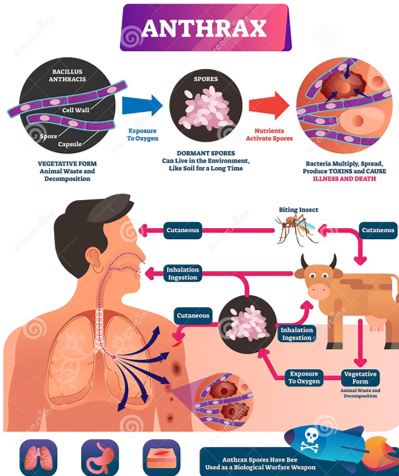

Context
After finding several carcasses of wild boar, Kerala health officials recently confirmed the presence of anthrax in Thrissur district.
About
What is Anthrax?
- Anthrax, also known as malignant pustule or woolsorter’s disease.
- It is a rare but serious disease caused by the rod-shaped bacteria known as Bacillus anthracis.
- It occurs naturally in soil.
- According to the WHO, it is primarily a disease of herbivores, with both domestic and wild animals being affected by it.
- Anthrax is a zoonotic disease, meaning that it is naturally transmissible from animals (usually vertebrae) to humans.
- People can get the disease through contact with infected animals or animal products that are contaminated with bacteria.
- According to the WHO, Anthrax is generally regarded as non-contagious.
- There have been instances of person-to-person transmission, however, such instances are extremely rare.
How do humans get infected?
- Humans almost always contract the disease directly or indirectly from animals or animal products.
- According to the Centres for Disease Control and Prevention (CDC), people get infected with anthrax when spores enter the body, through breathing, eating contaminated food or drinking contaminated water, or through cuts or scrapes in the skin.
- The spores then get “activated” and multiply, spreading across the body, producing toxins and causing severe illness.
Symptoms:
- A group of small blisters or bumps that may itch
- Swelling can occur around the sore
- A painless skin sore (ulcer) with a black center that appears after the small blisters or bumps. Most often the sore will be on the face, neck, arms, or hands.
Types of Anthrax
- Cutaneous:Most common form of anthrax infection, and is considered to be the least dangerous. Infection usually develops from 1 to 7 days after exposure.
- Inhalation:Inhalation anthrax is considered to be the most deadly form of anthrax. Infection usually develops within a week after exposure, but it can take up to 2 months
- Gastointestinal: Gastrointestinal anthrax has rarely been reported. Infection usually develops from 1 to 7 days after exposure.
- Injection: This type of infection has never been reported.
Prevention
- Antibiotics can prevent anthrax from developing in people who have been exposed but have not developed symptoms.
- Ciprofloxacin and doxycycline are two of the antibiotics that could be used to prevent anthrax.
- People who have been exposed to anthrax must take antibiotics for 60 days. This will protect them from any anthrax spores in their body when the spores are activated.



